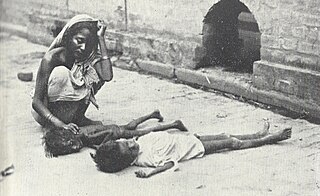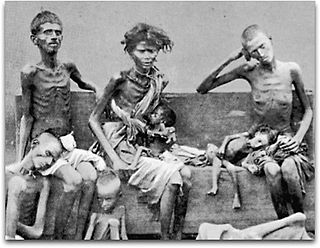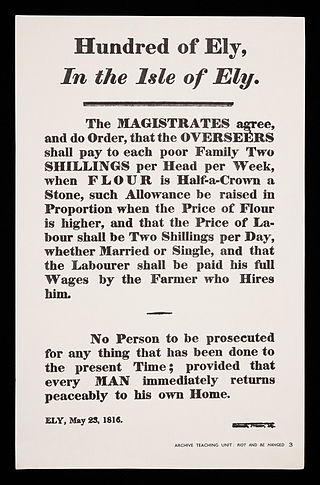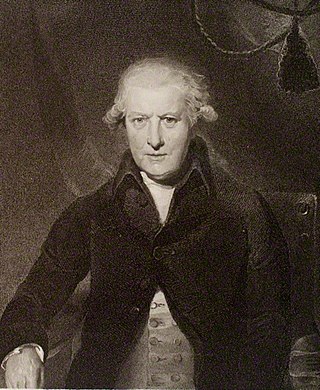Related Research Articles

Enclosure or inclosure is a term, used in English landownership, that refers to the appropriation of "waste" or "common land" enclosing it and by doing so depriving commoners of their rights of access and privilege. Agreements to enclose land could be either through a formal or informal process. The process could normally be accomplished in three ways. First there was the creation of "closes", taken out of larger common fields by their owners. Secondly, there was enclosure by proprietors, owners who acted together, usually small farmers or squires, leading to the enclosure of whole parishes. Finally there were enclosures by Acts of Parliament.

The English Poor Laws were a system of poor relief in England and Wales that developed out of the codification of late-medieval and Tudor-era laws in 1587–1598. The system continued until the modern welfare state emerged after the Second World War.
The Speenhamland system was a form of outdoor relief intended to mitigate rural poverty in England and Wales at the end of the 18th century and during the early 19th century. The law was an amendment to the Elizabethan Poor Law. It was created as an indirect result of Britain's involvements in the French Revolutionary and Napoleonic Wars (1793–1815).

Samuel Whitbread was a British politician.

The Forest of Dean is a geographical, historical and cultural region in the western part of the county of Gloucestershire, England. It forms a roughly triangular plateau bounded by the River Wye to the west and northwest, Herefordshire to the north, the River Severn to the south, and the City of Gloucester to the east.

The Swing Riots were a widespread uprising in 1830 by agricultural workers in southern and eastern England in protest of agricultural mechanisation and harsh working conditions. The riots began with the destruction of threshing machines in the Elham Valley area of East Kent in the summer of 1830 and by early December had spread through the whole of southern England and East Anglia. It was to be the largest movement of social unrest in 19th-century England.

The Bengal famine of 1943 was an anthropogenic famine in the Bengal province of British India during World War II. An estimated 0.8–3.8 million people died, in the Bengal region, from starvation, malaria and other diseases aggravated by malnutrition, population displacement, unsanitary conditions and lack of health care. Millions were impoverished as the crisis overwhelmed large segments of the economy and catastrophically disrupted the social fabric. Eventually, families disintegrated; men sold their small farms and left home to look for work or to join the British Indian Army, and women and children became homeless migrants, often travelling to Calcutta or other large cities in search of organised relief.
Moral economy is a way of viewing economic activity in terms of its moral, rather than material, aspects. The concept was developed in 1971 by British Marxist social historian and political activist E. P. Thompson in his essay, "The Moral Economy of the English Crowd in the Eighteenth Century". He referred to a specific class struggle in a specific era, seen from the perspective of the poorest citizens—the "crowd".

The Bristol Channel floods of 30 January 1607 drowned many people and destroyed a large amount of farmland and livestock during a flood in the Bristol Channel area of the UK. The known tide heights, probable weather, extent and depth of flooding, and coastal flooding elsewhere in the UK on the same day all point to the cause being a storm surge rather than a tsunami.

Famine had been a recurrent feature of life in the South Asian subcontinent countries of India and Bangladesh, most notoriously under British rule. Famines in India resulted in millions of deaths over the course of the 18th, 19th, and early 20th centuries. Famines in British India were severe enough to have a substantial impact on the long-term population growth of the country in the 19th and early 20th centuries.

The Southern bread riots were events of civil unrest in the Confederacy during the American Civil War, perpetrated mostly by women in March and April 1863. During these riots, which occurred in cities throughout the Southern United States, hungry women and men invaded and looted various shops and stores.
The winter of 1894–1895 was severe for the British Isles with a Central England temperature (CET) of 1.17 °C or 34.1 °F. Many climatologists have come to view this winter as the end of the Little Ice Age and the culmination of a decade of harsh winters in Britain. Whereas the average CET for the 10 winters from 1885–1886 to 1894–1895 was 2.87 °C or 37.2 °F, no winter with a CET under 3.0 °C or 37.4 °F followed for 22 years and no month as cold as February or January 1895 until 1940. In contrast, between 1659 and 1894, no spell with every winter CET above 3.0 °C or 37.4 °F had lasted longer than 12 winters.
Events from the year 1795 in Great Britain.

A food riot is a riot in protest of a shortage and/or unequal distribution of food. Historical causes have included rises in food prices, harvest failures, inept food storage, transport problems, food speculation, hoarding, poisoning of food, and attacks by pests.

Agriculture in the United Kingdom uses 69% of the country's land area, employs 1% of its workforce and contributes 0.5% of its gross value added. The UK currently produces about 54% of its domestic food consumption.
The Flour War refers to a wave of riots from April to May 1775, in the northern, eastern, and western parts of the Kingdom of France. It followed an increase in grain prices, and subsequently bread prices; bread was an important source of food among the populace. Contributing factors to the riots include poor weather and harvests, and the withholding by police of public grain supplies from the royal stores in 1773–1774. This large-scale revolt subsided following wheat price controls imposed by Turgot, Louis XVI's Controller-General of Finances, and the deploying of military troops.

The Ely and Littleport riots of 1816, also known as the Ely riots or Littleport riots, occurred between 22 and 24 May 1816 in the Isle of Ely. The riots were caused by high unemployment and rising grain costs, similar to the general unrest which spread throughout England following the Napoleonic Wars.

Charles Wickstead Ethelston, also given as Wicksted (1767–1830) was an English cleric, now remembered for the part he played in his role as magistrate on 16 August 1819, ahead of the Peterloo massacre.

The Nottingham cheese riot started on 2 October 1766 at the city's Goose Fair. The riot came at a time of food shortages and rising prices in England. Violence broke out when local citizens intervened to prevent Lincolnshire merchants taking away Nottinghamshire cheeses they had bought at the fair. A warehouse, shops, and a cargo boat were looted and hundreds of cheese wheels were rolled through the streets. The army was deployed when the mayor was unable to restore control. One man was killed and others wounded as soldiers opened fire on the crowds. Order was eventually restored after some days of unrest.

The 1766 food riots took place across England in response to rises in the prices of wheat and other cereals following a series of poor harvests. Riots were sparked by the first largescale exports of grain in August and peaked in September–October. Around 131 riots were recorded, though many were relatively non-violent. In many cases traders and farmers were forced by the rioters to sell their wares at lower rates. In some instances, violence occurred with shops and warehouses looted and mills destroyed. There were riots in many towns and villages across the country but particularly in the South West and the Midlands, which included the Nottingham cheese riot.
References
- Hammond, J. L.; Hammond, Barbara (1912). The Village Labourer 1760-1832. Longhman Green & Co.